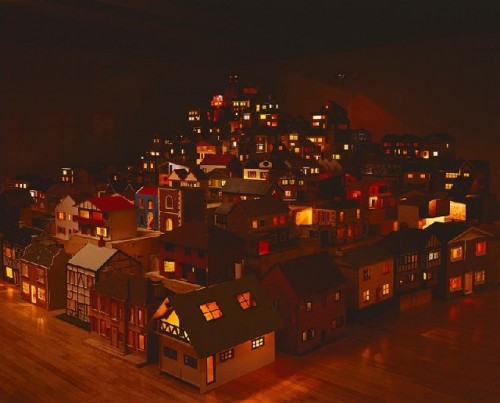Rachel Whiteread at the MFA
A OnceYoung British Artist Keeps Evolving
By: Shawn Hill - Oct 19, 2008
Rachel WhitereadPlace (Village)
Museum of Fine Arts
Oct. 15, 2008—January 25, 2009
Boston, MA
http://www.mfa.org
Rachel Whiteread's new show in the contemporary gallery at the MFA is a necropolis. The hundreds of dollhouses, arranged on simple boxes to cleverly emphasize the feeling of a gently rolling hillside, occupy a dark and silent room. Smaller houses have been placed further away in the back, to emphasize perspective, and each house has been carefully illuminated with electrical wiring so that windows glow in the night.
But shouldn't they also twinkle invitingly? The installation of such forms usually evokes feelings of holidays, with festive snow-covered drifts of land and sleighs with bells or trains with whistles giddily carving stately paths in and out of the idealized suburban or rural evocation. But the lighting feature is all there is in these miniatures. There's no furniture. No cars, no transportation. No people to stir at all, in fact, be they old abandoned dolls or jolly caricatures in porcelain or plastic. Rather than rest on simulated landscape, they are stacked unceremoniously on the packing crates they came in.
The lights become stark tools of interrogation in all these empty rooms, and the village begins to seem like a ghost town. Picture perfect from a distance, closer examination reveals these houses as barely finished and simplistic, with swatches of fabric and pattern here and there, but also the creases and bruises of age and wear and old, old use. Wallpaper peals. Rugs are stained. Corners are blunted, window mullions missing. Whiteread received many of these dollhouses as gifts, and others she purchased online. All speak to a lively time that has passed, to childhood fantasies abandoned (or sold) by anonymous grownups.
The whole eerie setting is a like a housing development project that never caught on, a warren of empty, personality-free boxes waiting for owners who never arrive. The neighborhood should have been opulent: for who would ever fantasize about a tiny, cramped house? These sprawling McMansions would be multi-family dwellings today (if life-size, that is); they seem decadent and over-generous from a jaundiced contemporary eye, so many dreams of affluence and material success and comfort gone unrealized.
This new work of Whiteread's has been augmented at the Museum by a small show of earlier works that provide a bit of context for the artist's domestic vocabulary. Some of these pieces look a little slight ("Untitled (Amber Floor)" looks especially wan, and "Circle" seems a minor practice study of casting), but the casts of "Double-Doors II (A+B)" have a stolid presence. More impressive is the modest collection of works on paper. A small set of drawings on graph paper use acrylic paint and correction fluid to achieve a gouache-like opacity in a few simple, telling shapes. The minimalism inherent to these drawings (which each feature a simple motif such as a door, floor or chair) is coupled with a fragile, delicate sense of gesture. Though limited and monochrome, these handmade visions are also monolithic and focused.
The mix of the iconic marred by traces of human use and wear characterizes "Place (Village)" as well. Whiteread is always about a warts and all exposure; all of her objects are evidence of human absence. This empty village reminds us of lives and histories we can no longer see, no less vibrant for having been abandoned and forgotten long ago.



